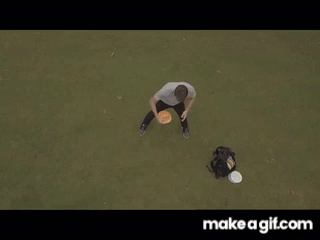I've read a lot on here about how important the front leg brace is to a backhand drive, and I've also read that your arm should feel like a whip.
In order to crack a whip, you have to decelerate the base of the whip in order to transfer kinetic energy out towards the tip of the whip. I'm assuming that in our analogy, this would mean that the hips and shoulders must decelerate before the "hit" and thereby transfer energy out to the lower arm and the disc? Is this accurate? And does this mean that the brace leg must decelerate the rotation of the hips before the "hit"?
Or is the above paragraph totally wrong, and it's instead true that the brace leg adds power by turning linear motion into rotational motion (thereby accelerating the hips all the way through the hit rather than decelerating them).
The whip effect makes sense to me intuitively, and I feel like I've read that kind of description several times on these forums. On the other hand, when I watch slomo videos of the pros, I can't see any deceleration of their hips until after the disc has left their hand, which seems to contradict the whip idea...? But maybe that's a trick of the eye.
So I guess my question is twofold:
1) Should hip rotation accelerate all the way through release of the disc, or is there an intentional deceleration of the hips before release of the disc?
2) What effect(s) should the brace leg have on rotational acceleration or deceleration of the hips throughout the various stages of the throw?
Many thanks in advance!
In order to crack a whip, you have to decelerate the base of the whip in order to transfer kinetic energy out towards the tip of the whip. I'm assuming that in our analogy, this would mean that the hips and shoulders must decelerate before the "hit" and thereby transfer energy out to the lower arm and the disc? Is this accurate? And does this mean that the brace leg must decelerate the rotation of the hips before the "hit"?
Or is the above paragraph totally wrong, and it's instead true that the brace leg adds power by turning linear motion into rotational motion (thereby accelerating the hips all the way through the hit rather than decelerating them).
The whip effect makes sense to me intuitively, and I feel like I've read that kind of description several times on these forums. On the other hand, when I watch slomo videos of the pros, I can't see any deceleration of their hips until after the disc has left their hand, which seems to contradict the whip idea...? But maybe that's a trick of the eye.
So I guess my question is twofold:
1) Should hip rotation accelerate all the way through release of the disc, or is there an intentional deceleration of the hips before release of the disc?
2) What effect(s) should the brace leg have on rotational acceleration or deceleration of the hips throughout the various stages of the throw?
Many thanks in advance!

